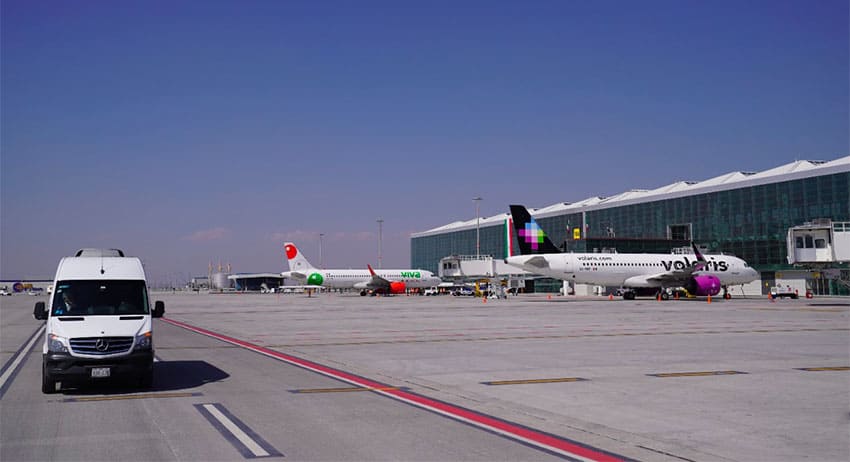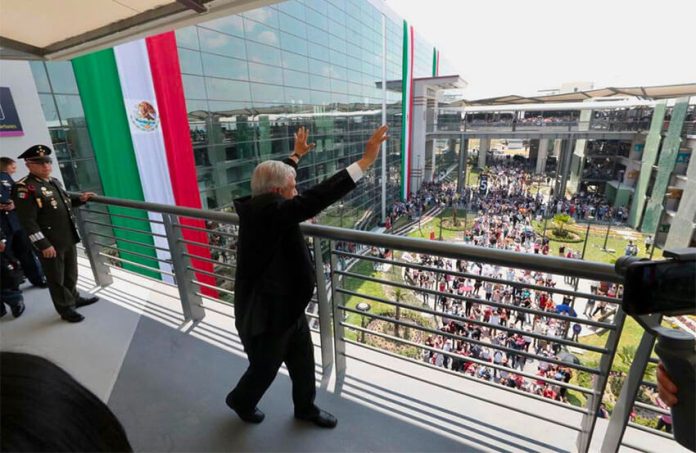Mexico City’s new airport will boast a paleontology museum, a housing complex for the military and a terminal with lucha libre-themed bathrooms. What is not yet clear is how many passengers will choose to use it.
Felipe Ángeles International Airport, which is about 40 kilometres from the city center and began operating Monday, will offer just seven passenger routes. Airline industry experts said crucial access infrastructure and more commercial incentives were still missing.
The only international flight from Felipe Ángeles is with Venezuela state carrier Conviasa to Caracas. President López Obrador said on Friday that he spoke to executives at U.S. airline Delta, which owns a stake in national flag carrier Aeroméxico, and that it was considering whether to add flights. Delta declined to comment.
The Mexican capital — with a metro area home to more than 20 million people — has experienced a decades-long aviation headache as policymakers failed to increase capacity.
One of López Obrador’s first acts as president was to scrap a partly-built US $13-billion Norman Foster-designed airport he said was mired in corruption, a move that rattled investors and signaled that his radical promises were not just campaign trail rhetoric.
López Obrador instead proceeded with the more modest Felipe Ángeles project, named after a revolutionary general. Like his other infrastructure plans, it was built by the military. After two and a half years of construction local media estimates the building will cost about 115 billion pesos ($5.6 billion).
“This project will benefit a lot of people, not just those that live in Las Lomas,” López Obrador said on Friday, referring to a high-income neighbourhood in the capital. “Little by little [the airlines] will come around and they will take all the spaces in the new airport.”
The lack of air capacity has long held back the capital’s economic growth and business leaders and economists argue that the decision to choose a network of medium-sized airports instead of one large hub would continue to hurt investment.
“In the best-case scenario if it’s successful . . . [Felipe Ángeles is] a medium-sized airport, it’s not proportionate to the needs of Mexico City,” said Luis de la Calle, a board member of Aeroméxico who spoke in his capacity as an economic consultant.
“The main beneficiaries of Mexico City not having a big airport are airports in other parts of Mexico and other places in the U.S.,” he added. Mexico City airport received 50 million passengers in 2019, roughly the same as the U.K.’s Gatwick airport. The Mexican government said Felipe Ángeles would initially have capacity for 20 million passengers, but airline executives said it needed strong financial incentives to keep ticket prices low as well as access roads and a train in order to grow.
On Thursday, just days ahead of its opening, hundreds of construction workers were still working on partly-built bridges and roads and digging ditches; not all the work will be finished in time for the official launch.

The government says a train taking airport passengers to and from the city center in 39 minutes will be ready in the second half of 2023.
“Airports in other parts of the world that are connected by train work very well,” said Juan Carlos Zuazua, chief executive of Mexican low-cost carrier VivaAerobus, who cited London’s Stansted as an example.
Felipe Ángeles’ airport passenger tax will be less than half that at Mexico City airport. But given its similar operating costs, combined with initially slower and more expensive transport from large swaths of the city, airlines would need more incentives to attract passengers, industry executives said.
Zuazua said the project would work but the government had to provide good incentives and connectivity. “It’ll be a success but in the medium [or] long term, it won’t be overnight.”
The airport’s commercial strategy will be in the hands of the military, which López Obrador has also put in charge of critical infrastructure from trains to ports.
Raúl Benítez Manaut, a professor at the National Autonomous University of México who has studied the country’s security forces, said López Obrador sees the military as more honest and efficient than bureaucrats. However, their ability to operate large-scale infrastructure is unproven and comes with governance risks.
“They have the capacity to administer resources to build things, but not to run a business,” he said. “It’s militarization of areas that should be civilian . . . it’s bad for a democracy.” Mexico’s defense ministry did not respond to a request for comment.
Like airlines around the world, Mexico’s carriers were thrown into turmoil by the coronavirus pandemic. Aeroméxico has just emerged from bankruptcy protection, while budget airline Interjet is also restructuring. Last year the U.S. Federal Aviation Administration downgraded Mexico’s aviation safety rating, which means it cannot add new flights to its main international destination. Airline executives said they expect the country to be upgraded again in the coming months.
Zuazua at VivaAerobus said the industry was ready to scale up flights at the new airport if it makes commercial sense — but the government could not force the issue. “In the end, we respond to consumer demand.”
Copyright The Financial Times Limited 2022. All rights reserved.
